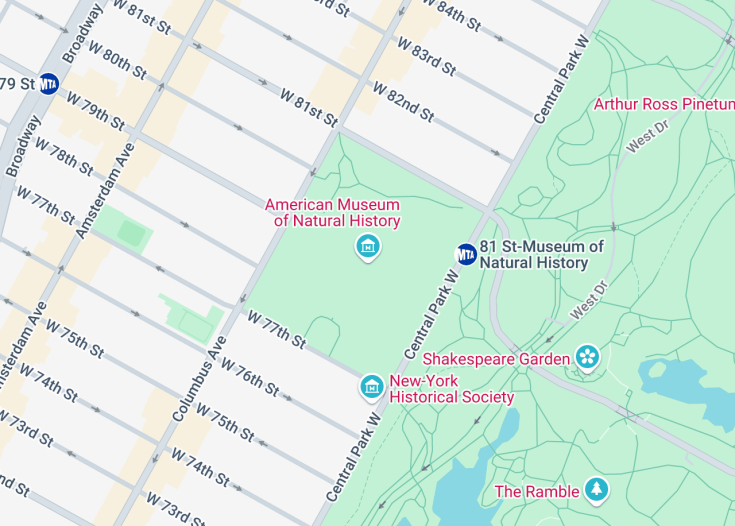The American Museum of Natural History, located adjacent to New York’s Central Park, is a treasure trove of over 34 million specimens and artifacts reflecting the planet’s vast biodiversity and cultural heritage. Esteemed as one of the largest and most innovative natural history museums worldwide, it fosters a deeper understanding through its comprehensive exhibitions, including the famous dinosaur halls and the Rose Center for Earth and Space. This institution not only preserves extensive anthropological collections but also engages in dynamic research and education, making it a pillar of scientific inquiry and discovery.
To make the most out of your visit, contact the museum ahead of time to inquire about guided tours and upcoming special exhibitions.
Plan your visit during weekdays or early mornings to avoid large crowds, allowing for a more immersive and enriching exploration of the museum’s vast offerings.
A Glimpse into Our World’s Past
The American Museum of Natural History in New York, USA, is a portal to the wonders of the natural world. Situated across from Central Park, this museum is one of the largest and most celebrated museums globally. Its extensive collections include over 33 million specimens of plants, animals, fossils, minerals, rocks, meteorites, human remains, and cultural artifacts. It’s not just a museum; it’s an expedition into the depths of science, nature, and the cosmos. From the vibrant display of the Butterfly Conservatory to the awe-inspiring sight of the dinosaur skeletons, every turn offers an educational adventure making it a significant point of interest for tourists. The museum also hosts varying special exhibitions that delve deeper into specific themes like climate change, space exploration, and ocean life. Whether you’re a science enthusiast, a history buff, or just looking for a fascinating day out, the American Museum of Natural History is a must-visit.
Discover the Titans of Prehistory
The American Museum of Natural History is renowned for its Fossil Halls featuring a compelling array of dinosaur skeletons. Among the most famous exhibits is the
Dinosaur Wing
, which showcases the giant Tyrannosaurus rex and the Triceratops. As you explore, you’ll feel as though you’ve stepped back in time. Another impressive exhibit is the
Milstein Hall of Ocean Life
, highlighted by a 94-foot long blue whale model suspended from the ceiling, creating a mesmerizing experience. Each exhibit is designed to educate about the biodiversity of the past and the necessary steps for conservation in the future.
Lucy’s Legacy
One of the most fascinating exhibits at the American Museum of Natural History is the discovery of Lucy, a significant early human ancestor. Found in Ethiopia in 1974, Lucy’s fossilized remains are over 3.2 million years old. This discovery has been pivotal in the study of human evolution, highlighting the connection between present-day humans and their ancient ancestors. Lucy’s small stature and partial skeletal preservation offer incredible insights into the walking capabilities and physical appearance of early hominids.
Explore the wonders at the American Museum of Natural History
The American Museum of Natural History is a vibrant hub of learning that appeals to a broad audience, including families, school children, science enthusiasts, and tourists of all ages. Visitors to the museum can expect an enriching experience that includes a variety of exhibits ranging from dinosaurs to ocean life and human cultures. The museum offers interactive displays and educational programs that are particularly beneficial for young minds, making it a great destination for family outings. Couples and older visitors will appreciate the thorough scientific insights and the majestic display of the universe in the Rose Center for Earth and Space.
Discover the best times to visit American Museum of Natural History
Visiting the American Museum of Natural History can be enjoyed year-round, but the best time to visit is during the weekday mornings when crowds are smaller. The museum is also particularly enchanting during the holiday seasons, when special exhibits and events take place.
Spotlight events
The annual Museum Gala is an excellent opportunity for those interested in a more sophisticated experience, combining entertainment with a deeper appreciation for the sciences.
Accessibility and limitations at the museum
Accessibility
Limitations
- Camera Usage: Restricted in certain exhibits
- Food and Beverage: Not allowed inside exhibit halls
- Smoking: Prohibited in all areas
Notes to visitors
- Strollers are permitted but may be restricted in certain areas due to crowd size
- Backpacks larger than a standard school bag may not be allowed
General information
Details for your visit to American Museum of Natural History
Location
The Museum is easily accessible via major transport systems and is close to Central Park.
Address: Central Park West & 79th St, New York, NY 10024, USA
Opening hours
Open daily from 10 AM to 5:45 PM, except on Thanksgiving and Christmas Day.
How to reach the American Museum of Natural History
Subway
Visitors can take the B (weekdays only) or C trains to 81st Street.
Car
Parking is available at several nearby lots. However, public transportation is encouraged due to traffic.
| Route | Distance | Travel time |
|---|---|---|
| From JFK Airport | 17 miles | 50 minutes |
| From Times Square | 3 miles | 15 minutes |
Nearby attractions
- Central Park – 0.5 miles (0.8 km)
- Lincoln Center – 1.2 miles (1.9 km)
- Times Square – 3 miles (4.8 km)
- Empire State Building – 3.5 miles (5.6 km)
- One World Observatory – 7.5 miles (12 km)
Common questions
What are the must-see exhibits at the American Museum of Natural History?
How long does it typically take to tour the American Museum of Natural History?
Are there guided tours available at the American Museum of Natural History?
What educational programs are available for children at the museum?
Can visitors take photos inside the museum?
Are there dining options available within the museum?
What types of research facilities are associated with the museum?
Is the American Museum of Natural History accessible for visitors with disabilities?
Can I hold a private event at the museum?
Does the museum have a gift shop?
Are pets allowed in the museum?
What special accommodations are offered for international visitors?

Is the American Museum of Natural History in New York City worth visiting?
The American Museum of Natural History in New York City is renowned for its extensive and fascinating exhibits that span across various domains of science, including astronomy, biology, and anthropology. With the famous Hall of Biodiversity and the Rose Center for Earth and Space, visitors can immerse themselves in a vast array of information and artifacts that are both educational and engaging.
However, one possible drawback is its popularity, which leads to large crowds, especially during peak tourist seasons, which can detract from the personal experience of the exhibits. For those who prefer a quieter, more contemplative museum visit, the nearby New York Historical Society offers a less crowded alternative with rich historical insights.










